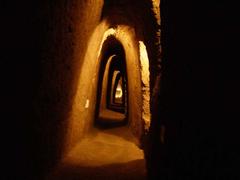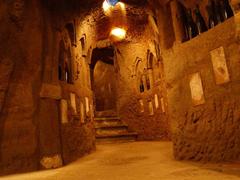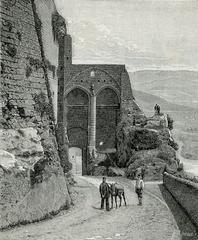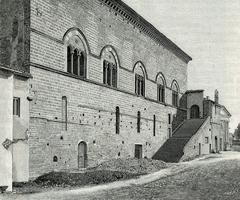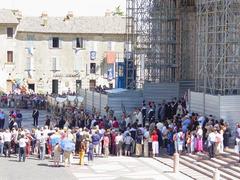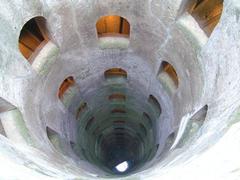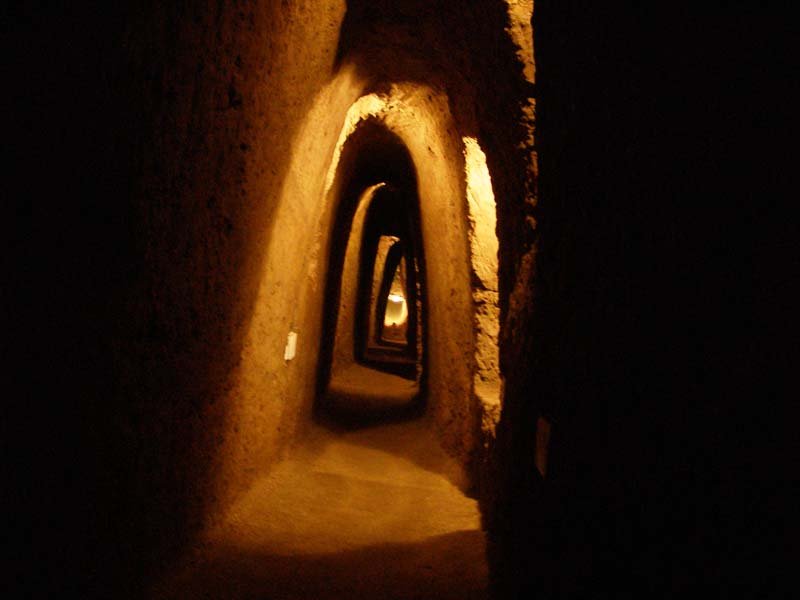
Orvieto Subterranea: Visiting Hours, Tickets, and Historical Insights
Published Date: 16/08/2024
Introduction to Orvieto Subterranea
Nestled in the heart of Italy’s Umbria region, Orvieto is a city renowned for its rich history and remarkable architectural feats. Among its many attractions, the Orvieto Subterranea—or Orvieto Underground City—stands out as a testament to human ingenuity and resilience. This hidden labyrinth of tunnels, caves, and chambers has been shaped over millennia by various civilizations, from the Etruscans to the medieval inhabitants and even during World War II. The underground city offers a unique glimpse into the past, showcasing the advanced engineering and strategic planning of its ancient residents. Discovering this subterranean world is like stepping back in time, offering insights into the daily lives, cultural practices, and survival strategies of the people who once thrived beneath Orvieto’s surface (The Brain Chamber, Ancient Pages).
Table of Contents
History of the Orvieto Underground City
Etruscan Origins
The origins of the Orvieto Underground City trace back over 2,500 years to the Etruscan civilization. The Etruscans, known for their advanced engineering and artistry, established Orvieto as a flourishing settlement atop a steep hill composed of volcanic tufa rock. This strategic location provided natural defenses and facilitated the creation of an extensive network of underground passages, caverns, and storerooms. These subterranean spaces were meticulously carved out of the tufa rock, showcasing the Etruscans’ remarkable engineering skills (Orvieto Underground).
The Etruscans utilized these underground structures for various purposes, including water storage, food preservation, and as refuges during times of conflict. The presence of wells and cisterns indicates their foresight in ensuring a reliable water supply, crucial for their survival. The labyrinthine network also served as a means of escape from invaders, reflecting the Etruscans’ strategic planning and adaptability (Ancient Pages).
Medieval Reinvention
During the medieval period, the underground city of Orvieto underwent significant transformations. The existing Etruscan tunnels and caverns were repurposed and expanded to meet the needs of the growing population. The medieval inhabitants of Orvieto continued to utilize these subterranean spaces for storage, particularly for agricultural products such as olive oil and wine. The presence of ancient oil mills and wine cellars highlights the region’s long-standing culinary heritage (The Brain Chamber).
The underground city also played a crucial role during times of conflict. During World War II, the tunnels served as bomb shelters, providing protection for the residents of Orvieto. This adaptability and continued use of the underground spaces underscore their timeless design and the ingenuity of the people who created and maintained them (The Brain Chamber).
Accidental Discovery
The discovery of the Orvieto Underground City was a serendipitous event. In 1972, a private homeowner, while expanding his cellar, stumbled upon a network of ancient tunnels. This accidental discovery sparked interest and led local speleologists to explore further, uncovering a vast labyrinthine complex beneath the modern city. The extent and preservation of these subterranean spaces amazed researchers and revealed a hidden chapter of Orvieto’s past (Orvieto Underground).
Following the initial surprise, the discovery was kept discreet to prevent reckless intrusions. Authorized archaeologists conducted meticulous explorations, mapping corridors, wells, and chambers. This careful documentation ensured the preservation of the site for future generations to study and explore (Orvieto Underground).
Cultural Significance
The cultural significance of the Orvieto Underground City is deeply rooted in its Etruscan legacy. The Etruscans’ artistry and engineering prowess are evident in the intricate design of the underground passages and chambers. These subterranean spaces were not only practical but also held spiritual significance. Ritual sites found underground suggest a spiritual connection to these spaces, adding a dimension of sacredness to the city’s practical uses (The Brain Chamber).
The underground city serves as a living museum of ancient culture, offering a glimpse into the daily lives and celebrations of the Etruscans. The presence of pigeon coops, olive mills, and wine cellars highlights the region’s agricultural practices and culinary heritage. These artifacts and structures connect present-day visitors with the rich tapestry of human innovation and survival that thrived in this unique sub-city (The Brain Chamber).
Preservation and Tourism
Efforts to preserve and study the Orvieto Underground City have allowed tourists and scholars to delve deep beneath the city and uncover its secrets. Guided tours reveal the city’s incredible engineering and the adaptability of its ancient residents. Visitors can explore the labyrinthine network of tunnels and chambers, witnessing the remnants of Etruscan, medieval, and Renaissance periods etched into the walls (The Brain Chamber).
Visitor Information
Visiting Hours
For those planning to visit the Orvieto Underground City, it is advisable to make reservations several days in advance, especially during peak tourist seasons. Guided tours are available, providing valuable insights into the history and significance of the underground spaces. The tours typically last about an hour and offer a comprehensive overview of the site’s historical and cultural importance (Earth Trekkers).
Visiting Hours: The Orvieto Underground City is generally open daily from 9:00 AM to 7:00 PM, but hours may vary, so checking the official website or contacting local tourist information is recommended.
Tickets
Tickets can be purchased online or at the site. Prices generally range from €6 to €10 for adults, with discounts available for children, students, and seniors.
Special Attractions
One of the most interesting underground attractions is the Pozzo della Cava, an ancient cave well over 2,000 years old. Originally built to provide water for the Etruscan settlement, the well features multiple levels of tunnels and rooms carved out of the tufa rock. Visitors can descend about 118 feet (36 meters) below the surface and explore the tunnels, which are adorned with ancient inscriptions, medieval Christian symbols, and more recent graffiti (Salt in our Hair).
Visitor Tips
Visitors should also consider exploring other attractions in Orvieto, such as the Torre del Moro (Moro Tower) and the Albornoz Fortress. The Torre del Moro offers panoramic views of the Umbrian countryside, while the Albornoz Fortress, located next to the top of the funicular track, hosts Orvieto’s public gardens (Salt in our Hair).
FAQ
What are the visiting hours for Orvieto Underground City?
The Orvieto Underground City is generally open daily from 9:00 AM to 7:00 PM, but hours may vary, so checking the official website or contacting local tourist information is recommended.
How to buy tickets for Orvieto Underground City?
Tickets can be purchased online or at the site. Prices generally range from €6 to €10 for adults, with discounts available for children, students, and seniors.
Conclusion
The Orvieto Underground City is a testament to human ingenuity and resilience. Its rich history, cultural significance, and well-preserved artifacts make it a must-visit destination for history enthusiasts and curious travelers alike. By exploring the labyrinthine tunnels and chambers, visitors can step back in time and connect with the ancient civilizations that once thrived beneath the modern city of Orvieto. Be sure to plan your visit, secure your tickets, and immerse yourself in this remarkable historical site.
References and Further Reading
- The Brain Chamber. History of the Orvieto Underground City. Retrieved from https://thebrainchamber.com/orvieto-underground-city/.
- Ancient Pages. Underground Orvieto: Etruscan City Under a City with Labyrinth Tunnels, Pyramidal Structures, Oil Mills, and Water Supply. Retrieved from https://www.ancientpages.com/2022/07/02/underground-orvieto-etruscan-city-under-a-city-with-labyrinth-tunnels-pyramidal-structures-oil-mills-and-water-supply/.
- Orvieto Underground. The Discovery. Retrieved from https://www.orvietounderground.it/index.php/en/orvieto-underground-en/the-discovery.
- Earth Trekkers. Best Things to Do in Orvieto, Italy. Retrieved from https://www.earthtrekkers.com/best-things-to-do-in-orvieto-italy/.
- Salt in our Hair. Orvieto. Retrieved from https://www.saltinourhair.com/italy/orvieto/.
